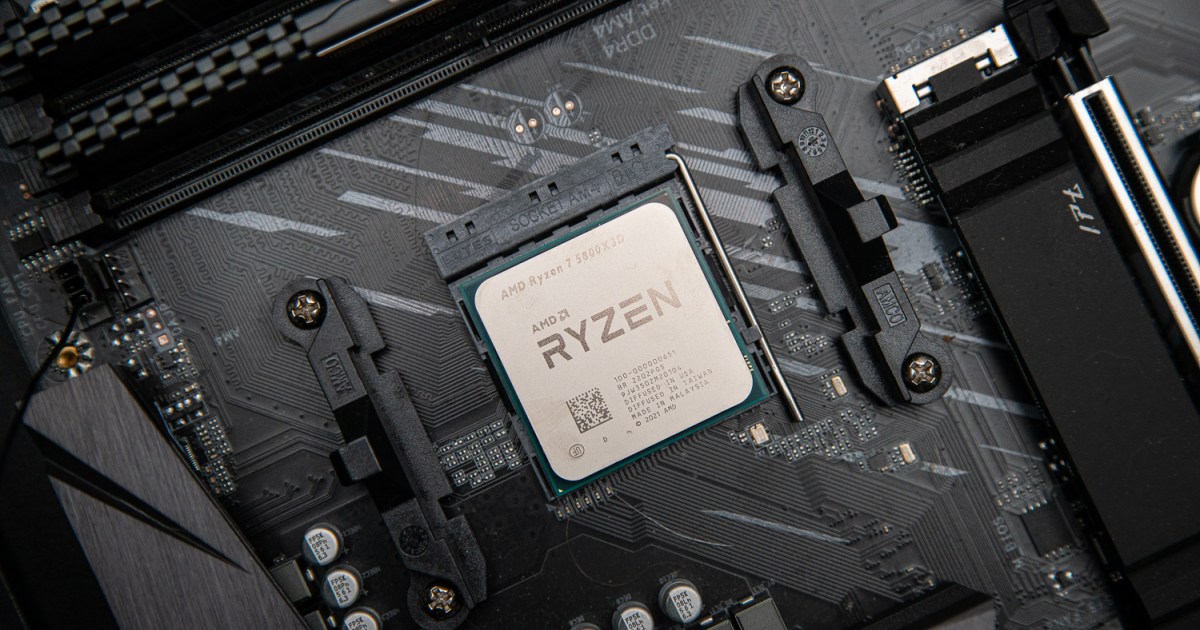When AMD launched its Ryzen processors on a newly minted AM4 socket in 2017, it was a game changing moment. Finally, AMD was bringing back real competition to Intel. But while Ryzen was killing off the relevance of the venerable quad core, it was also introducing a new idea of socket longevity that would see gamers able to evolve their PCs over time, rather than ripping their guts out every few years.
AM4 went on to be AMD’s flagship socket for more than half a decade. But while team red has since moved on to newer sockets and CPUs, AM4’s sheer lifespan has become one of its most defining features. It’s become something expectant from AMD fans for socket AM5 and beyond.
While AM4’s longevity has surprised us all, though, a long-lasting socket was something AMD had planned from the start. To find out more about the humble beginnings of Ryzen and the sockets that powered it, DigitalTrends sat down with AMD’s product management lead for gaming and workstations, Sourabh Dhir.
Building for the long term
“So AM 4 is coming up to it’s almost eighth here now, which is really remarkable,” Dhir said. “The way we look at our platform, road map and platform generations, one of the core tenets of our strategies, really: how do we serve our end consumer base?”
“Our core strategy here at AMD […] is always to minimize the burden on our end users and and design the platform in a way which would last multiple generations.”
That was the plan with AM4, he said, and it was the plan for AM5 too. The current AMD socket has planned support in place through 2028, even if a new AM6 socket appears before then. But while AMD does consider consumer needs when building in this kind of longevity to its products, Dhir did admit there was a business decision there, too.
When consumers with AM4 or AM5 motherboards come to upgrade, AMD maintaining socket longevity means they will only have to buy a new CPU to upgrade, rather than a full motherboard and memory. But it also means those consumers will almost certainly buy an AMD CPU. Because if they wanted to buy anything else, they would have to buy a new motherboard as well.
“They can definitely just buy the next generation of AMD CPU,” Dhir said. “So from that point of view it’s like I said it’s it’s a good business strategy. It it’s a win win situation for everyone across the ecosystem.”
While I had assumed motherboard partners would likely prefer a more regular socket change, prompting AMD users to upgrade their motherboards too, Dhir suggested the opposite was in fact true. By keeping the same socket, there are defined parameters for board partners to work in. Certain power limits and specific supporting technologies. They can then focus on bringing costs down with economy of scale production and refine the designs, rather than having to reinvent the wheel every few years.
“It really helps [board partners] to drive their investments for all the components to get down the cost curve,” Dhir explained. “All our ecosystem partners are also making investments into making a platform. And if you if you have the right longevity, they they really appreciate it.”
“If our motherboard partners want to launch new motherboards within the same socket infrastructure, there are innovations. There are features they can add, and they’ve been doing that we’ve we’ve launched new versions of AM5, new versions of AM4 motherboards, etc.”

This ultimately helps them evolve their business strategy to focus on profitability, alongside feature innovation, rather than having to redesign entirely new boards. From the end-user perspective, too, boards can evolve to become more capable. An AMD running on a 300-series chipset was a very different beast to one running on a 500-series board.
Taking it on the chin
None of that is to say that this strategy is perfect for AMD. There’s a reason that Intel and AMD has have historically only kept a socket around for a generation or two, and it’s not just because it encourages fans to upgrade more often. But in maintaining the socket for a few more years, AMD is forced to innovate within those constraints, leading to what Dhir believes are better products for consumers.
“It’s much easier to every every generation or two if we just throw a new infrastructure,” he said. “The degrees of freedom are much easier. But if we start with the engineering challenge that we need to remain within the boundaries of AM4 and and what that does is the innovations have to come from other places.”

The innovations have to come from the CPU architecture or the motherboard design, rather than just upgrading the socket to throw more power at the problem.
“Not everything has to come from changing the infrastructure,” Dhir said. “There are power improvements. There are socket improvements. You don’t have to change the pin out of the socket, but there are innovations within that same pin out. There’s thermal improvements, there’s electrical signal integrity, there’s mechanical improvements.”
“We can do [a lot] without really moving to the next generation of overall infrastructure.”
How to move on
If AMD is specifically trying to keep its sockets relevant for as long as possible, when does it finally draw the line under AM4 and in the future, AM5, and decide it needs to move on to a new platform? Despite knowing the investment that will require from gamers and fans who have grown used to more incremental upgrades.
“A road map we keep in mind is the memory, right?” Dhir answered. “So if you look at AM4, you can map it to the life of how our memory ecosystem was developing. When when DDR5 came into market, we wanted to adopt that technology early. We wanted to give the benefits of that, improved bandwidth, improved memory capabilities to our end users.”
“That was one of the major driving factors when we decided, OK, it’s it’s time to [move to a new socket design].”

It was also keen to upgrade the PCIExpress generation support, and indeed it brought support for PCIe 5 to AM5. But it was memory that was the major driving factor, something Dhir suggested may well be the primary force for moving on from AM5 in the future.
In for the long haul
Despite AMD focusing more on AM5 and eyeing up DDR6 as a potential reason to move on to AM6 in the future, it still maintains support for AM4. New 5900XT and 5800XT CPUs were launched in 2024, and we had unique 5700X3D and 5600X3D CPUs show up in 2023. Motherboard manufacturers continue to release BIOS updates for AM4 boards — sometimes pushed by AMD, other times by its board partners.
AMD was very keen to avoid talking about the future during our discussion, but when pressed, Dhir suggested AMD had no plans to halt AM4 support in the near term. And that’s not just because it wants to string the socket along: It has a very real place in AMD’s product stack, even nearly eight years after its debut.
“The way we look at it is we have we we we are covering all price bans in the market and and am 4 covers certain price bands,” Dhir said. “We always think about can we offer something new to them which still operates within the AM4 infrastructure? Still gives them an upgrade path. Still gives them an uplift in the gaming performance. So from that point of view, we we’re always looking to improve.”
Does that cannibalize AM5? Surely if AMD was more ruthless and killed off AM4 it would push gamers and enthusiasts still working and gaming on AM4 to move to a newer platform?

“I don’t believe there’s a cannibalization happening if we innovate for our value conscious users,” Dhir said. “The market is really segmented into different price bands and then each price band the users are trying to get the best out of within within that price range.”
AMD PR manager, Matthew Hurwitz backed him up here too, highlighting that maintaining AM4 allowed AMD fans on tighter budgets to continue to improve their system with a modest upgrade. That, he said, was respectful of their needs and available budgets.
“I think as an industry, working at AMD and and working with all of our press and reading the articles, we miss a dimension of building PCs, which is it’s not usually a blank piece of paper, right? I deal with a lot of my friends who are like, should I upgrade my CPU or my GPU, right?”
They don’t have to worry about upgrading anything else.
“When [Dhir] talks about price bands, it’s not just I have X to spend on a CPU, it’s I have X to spend on getting better gaming performance. Yes, [the latest] X3D CPUs are going to give you the better game performance, but maybe I just get an X class and I go up a GPU instead.”
Taken to heart
As we wrapped up our discussion, I asked Dhir if there was anything else he wanted to talk about before we finished, and he was very keen to reiterate what a core tenet of AMD’s strategy socket longevity is. It separates AMD from the competition, he said, because it’s willing to do it even if it’s a challenge to AMD engineers.
“What we’re doing is we’re taking the pains,” he said. “Rather than passing it on to our end consumers and innovating with that constraint in mind. It is just something we believe that’s the right thing to do for everyone.”
That’s a noble goal, and one AMD users have undeniably benefitted from over the years. It’s not entirely altruistic—as evidenced by AMD’s steady climb up sales charts and the Steam Hardware Survey—but whether it’s for us, for them, or a bit of both doesn’t really matter.
Long-lasting sockets make upgrades simpler and cheaper for millions. That’s a win worth taking, regardless of where it comes from.



-%20CookUnity%20Prepared%20Meals.png)





.png)
